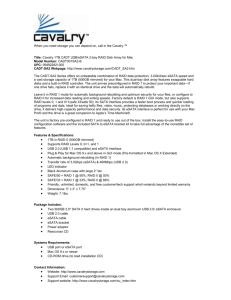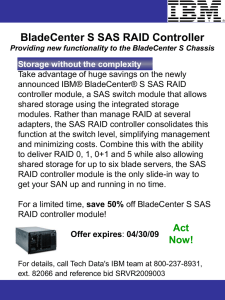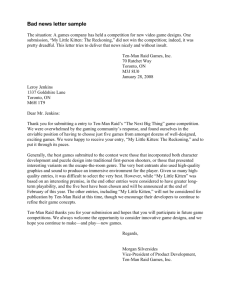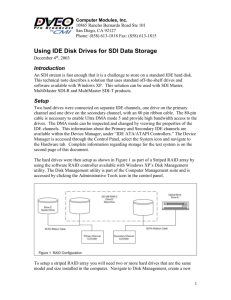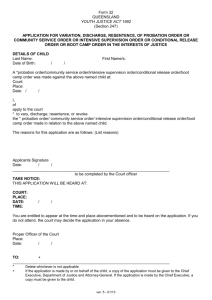RocketRAID 6G eSATA Boot Camp Installation Guide
advertisement
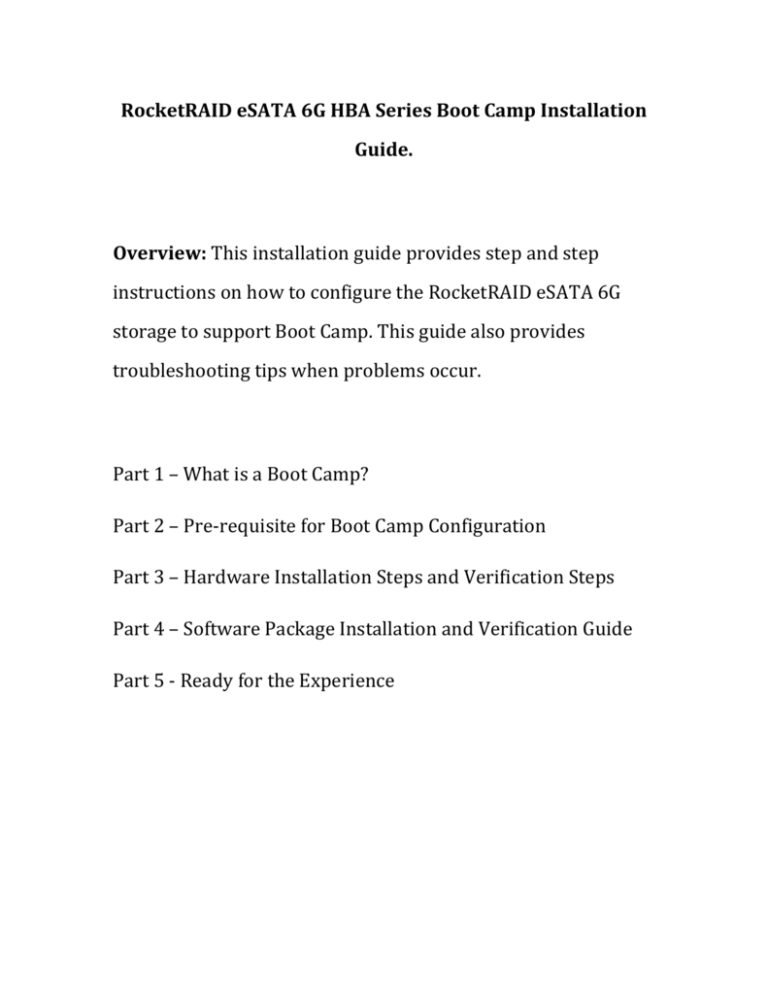
RocketRAID eSATA 6G HBA Series Boot Camp Installation Guide. Overview: This installation guide provides step and step instructions on how to configure the RocketRAID eSATA 6G storage to support Boot Camp. This guide also provides troubleshooting tips when problems occur. Part 1 – What is a Boot Camp? Part 2 – Pre-requisite for Boot Camp Configuration Part 3 – Hardware Installation Steps and Verification Steps Part 4 – Software Package Installation and Verification Guide Part 5 - Ready for the Experience Part 1 – What is a Boot Camp? Boot Camp is software included with Mac OS X 10.5 Leopard that lets you run compatible versions of Microsoft Windows on an Intel-based Mac. Boot Camp 4.0 is the latest version of Boot Camp. You can use Microsoft Windows 7 Home Premium, Microsoft Windows 7 Professional, or Microsoft Windows 7 Ultimate with Boot Camp. 64-bit versions of Windows 7 are supported. Note: Boot Camp releases before 4.0 support 32 and 64-bit releases of Windows Vista. Part 2 – Pre-requisite for Boot Camp Configuration System Requirements Mac Hardware: Intel-based Mac with an available PCIe 2.0 or 1.0 slot capable of supporting an x4 (4-lane) length PCIe card. For optimal performance, use a PCIe 2.0 slot running at x4 speeds or greater. Slot recommendations for the RocketRAID eSATA 6G series controller. Mac Pro Model 2006 Core / CPU Speed GHz Quad Core / 2.0, EFI 32-bit Slot Number 3,4 2006 2008 2008 2009 2009 2010 2010 2010 2010 2.66, 3.0 Eight Core /3.0 Quad Core / 2.8 Eight Core/ 2.8, 3.0, 3.2 Quad Core / 2.66/2.93/3.33 Eight Core / 2.26, 2.66, 2.93 Quad Core / 2.9, 3.2 Six Core / 3.3 Eight Core / 2.4 Twelve Core / 2.66, 2.93 32-bit 64-bit 64-bit 3,4 2,3,4 2,3,4 64-bit 2,3,4 64-bit 2,3,4 64-bit 64-bit 64-bit 64-bit 2,3,4 2,3,4 2,3,4 2,3,4 Operating System: Mac OS X 10.5.x, 10.6.x, and 10.7.x Hardware Installation Before, installing the RocketRAID eSATA 6G series controller make sure the computer is turned off and unplugged from its power source. Take appropriate electrostatic discharge precautions: Your computer is a static-sensitive device. It is susceptible to invisible damage if not protected during installation. We recommend proper grounding by using a grounding strap. Make sure to work in a clean and static-free area, and avoid wearing clothing that retains static charges. RAID Basics? RAID stands for Redundant Array of Independent Drives. This means taking multiple matching drives and arranging them together to achieve large storage space, speed, data protection, or any combination of the three. The RocketRAID eSATA 6G series controller supports the following RAID types: RAID 0 “Stripe” Speed: Data is alternated across two or more drives to gain speed by essentially distributing the workload. Protection: No built-in protection. Capacity: Usable space is the combined capacity of all the drives. RAID 5 “Stripe & Protection” Speed: Data is striped like in a RAID 0, so significant speed gains are seen. Protection: Utilizes mathematical parity to achieve data protection while taking up a minimum of space. One drive can fail and all data will still be accessible. Capacity: All but one drive worth of capacity is usable. Minimum three drives are needed to create a RAID 5 array. In a three drive RAID 5 array, there is two drives worth of usable space. Combined RAIDs: RAID 10 Speed: Combines multiple RAID 1 or RAID 5 sets by using RAID 0 “Striping” to gain speed. Protection: There are two RAID 1 “Mirrored” sets used in order to tolerate 1-2 drives failing depending on which drives they are. Capacity: Usable space is half of the combined capacity of all the drives used RAID 1 “Mirror” Speed: No speed benefits gained. Protection: One drive can fail and all data will still be accessible. Capacity: One drive worth of usable space out of the two total drives used. JBOD (Independent Drive Modes) Speed: No significant speed gains. Protection: No built-in data protection. Capacity: In JBOD mode, the capacities are combined. When set up as independent drives, each drive presents its stated capacity for use. Part 3 - Hardware Installation Steps and Verification Steps Before installing the RocketRAID eSATA 6G series controller Make sure computer is turned off and unplugged from its power source Take appropriate electrostatic discharge precautions:. Remove the PCIe slot cover. Gently insert the RocketRAID eSATA 6G series controller into the PCIe slot and secure the bracket to the computer chassis according to your chassis specifications. After installing the RocketRAID eSATA 6G series controller, start your computer. Part 4 - Software Package Installation and Verification Guide Installing Boot Camp Use the Mac OS X Boot Camp Assistant to prepare your hard drive for a fresh Windows installation. Once the Windows installation finishes you will need to install the Windows driver for the RocketRAID eSATA 6G series controller. Boot up into Windows and follow the driver installation procedure for the RocketRAID eSATA 6G series controller. Driver Installation The RocketRAID eSATA 6G series controller Windows drivers are available on the http://www.highpoint-tech.com . Windows 7 (Versions) Once you have installed the RocketRAID eSATA 6G series controller and downloaded the software package, boot into Windows and follow these instructions to install the device drivers: 1. Go to Control Panel and navigate to Device Manager 2. Double-click on the entry RAID Controllers 3. Follow the on-screen steps to complete the installation and you will be prompted to restart your Mac Pro system. Driver Verification Verify that the driver has installed correctly by following these steps. 1. Go to Control Panel and navigate to Device Manager 2. Right-click on the entry RAID CONTOLLER and RAID Controllers and select the property item. 3. You should see the entry for the RocketRAID eSATA 6G series controller Part 5 - Ready for the Experience Software Installation Once the driver verification has passed, you can proceed to install the HighPoint RAID management web GUI. The Window web GUI can be downloaded from the HighPoint website http://www.highpoint-tech.com/, look for the product RocketRAID 644. Log into web GUI Once the Windows web GUI is installed you can enter the web GUI to create a RAID array or manage the storage attached to the RocketRAID eSATA 6G series controller. Log into the web GUI by entering opening a browser and entering the following URL https://localhost:7402 User Name: RAID Password: hpt Troubleshooting Tip: If you are not able to login to the URL, please check previous troubleshooting steps to verify that the driver is install and that the RocketRAID eSATA 6G series controller is detected. Once you have successfully logged into the web GUI, you can create any supported RAID array or check any of the HDD attributes. Note: Any single HDD attached to the RocketRAID eSATA 6G series controller will be detected automatically.
